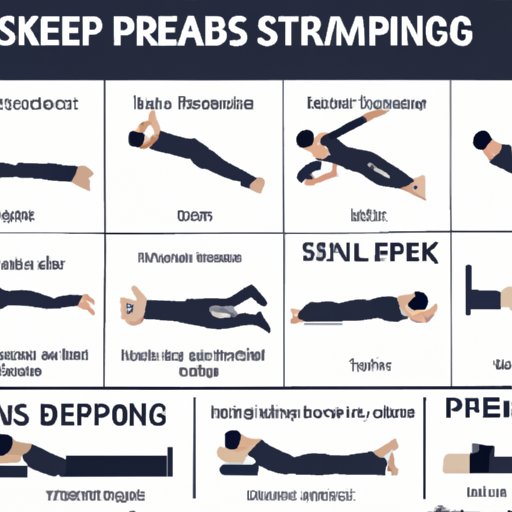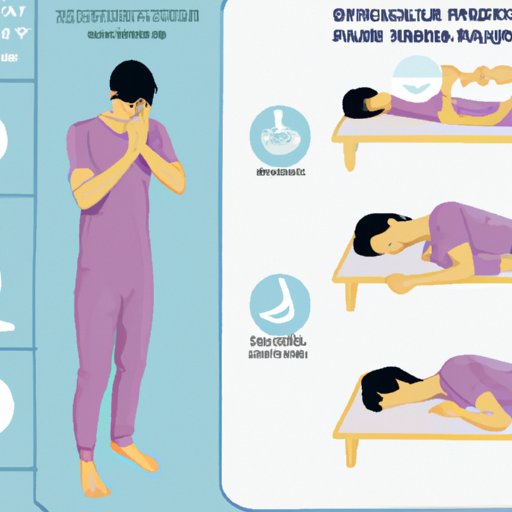Introduction
Sleeping position refers to the physical posture a person takes during sleep. It can range from lying on your back with both arms at your side to curling up in a ball on one side. While some people may not pay much attention to their sleeping position, it can have a significant impact on physical health and well-being. In this article, we’ll explore the benefits and drawbacks of various sleeping positions, as well as which ones are best for pain relief and overall health.

Overview of Commonly Used Sleeping Positions
There are three main sleeping positions that most people use: side sleeping, stomach sleeping, and back sleeping. Each position has its own set of advantages and disadvantages, so it’s important to understand the pros and cons of each before deciding which one is best for you.
Side Sleeping
Side sleeping is the most popular sleeping position. It involves lying on one side with the legs slightly bent and one arm tucked under the pillow. Side sleeping is beneficial because it keeps the spine in a neutral position which helps to reduce back pain. Additionally, it can help to reduce snoring and acid reflux.
Stomach Sleeping
Stomach sleeping is the least popular sleeping position, but it can still be beneficial. It involves lying on the stomach with the head turned to one side. Stomach sleeping can help to reduce snoring and can also be beneficial for those with neck and shoulder pain. However, it’s important to note that stomach sleeping can put extra strain on the back, which can lead to increased pain.
Back Sleeping
Back sleeping is the second most popular sleeping position. It involves lying on the back with the arms either by the side or above the head. Back sleeping can help to keep the spine in a neutral position, which can reduce back pain. Additionally, it can help to reduce snoring and reduce the risk of acid reflux. However, it’s important to note that back sleeping can lead to neck and shoulder pain if the head isn’t properly supported.

Comparing the Benefits and Drawbacks of Different Sleeping Positions
Now that we’ve discussed the three most commonly used sleeping positions, let’s take a closer look at the benefits and drawbacks of each.
Side Sleeping
The primary benefit of side sleeping is that it helps to keep the spine in a neutral position. According to a study published in the journal Sleep Medicine, side sleeping is the most beneficial position for reducing back pain. Additionally, side sleeping can help to reduce snoring and acid reflux. The only potential drawback of side sleeping is that it can lead to hip and shoulder pain if the position is maintained for too long.
Stomach Sleeping
The primary benefit of stomach sleeping is that it can help to reduce snoring and neck and shoulder pain. Additionally, it can help to reduce the risk of acid reflux. However, it’s important to note that stomach sleeping can put extra strain on the lower back, which can lead to increased pain. Additionally, it’s not recommended for those with breathing issues such as sleep apnea.
Back Sleeping
The primary benefit of back sleeping is that it helps to keep the spine in a neutral position. According to a study published in the journal Sleep Medicine, back sleeping is the second most beneficial position for reducing back pain. Additionally, it can help to reduce snoring and reduce the risk of acid reflux. The only potential drawback of back sleeping is that it can lead to neck and shoulder pain if the head isn’t properly supported.
Exploring the Best Sleeping Position for Pain Relief
When it comes to finding the best sleeping position for pain relief, side sleeping is generally considered to be the most beneficial. According to a study published in the journal Sleep Medicine, side sleeping is the most effective position for reducing back pain. Additionally, it can help to reduce snoring and acid reflux.

Examining the Pros and Cons of Common Sleeping Positions
Now that we’ve explored the benefits and drawbacks of the three most common sleeping positions, let’s take a closer look at how they can impact health and well-being.
Effects on Spine Alignment
One of the most important factors to consider when choosing a sleeping position is how it will affect spine alignment. According to a study published in the journal Sleep Medicine, side sleeping is the most beneficial position for keeping the spine in a neutral position, which can help to reduce back pain. Additionally, back sleeping can also help to keep the spine in a neutral position. However, it’s important to note that stomach sleeping can put extra strain on the lower back, which can lead to increased pain.
Potential Risk Factors
It’s also important to consider any potential risk factors when choosing a sleeping position. For example, side sleeping can increase the risk of developing hip and shoulder pain if the position is maintained for too long. Additionally, stomach sleeping can increase the risk of developing lower back pain. Finally, back sleeping can increase the risk of developing neck and shoulder pain if the head isn’t properly supported.
Analyzing the Advantages and Disadvantages of Various Sleeping Postures
Now that we’ve examined the effects of different sleeping positions on spine alignment and potential risk factors, let’s take a closer look at the advantages and disadvantages of each.
Pros and Cons of Side Sleeping
The primary advantage of side sleeping is that it helps to keep the spine in a neutral position, which can reduce back pain. Additionally, it can help to reduce snoring and acid reflux. The only potential disadvantage of side sleeping is that it can lead to hip and shoulder pain if the position is maintained for too long.
Pros and Cons of Stomach Sleeping
The primary advantage of stomach sleeping is that it can help to reduce snoring and neck and shoulder pain. Additionally, it can help to reduce the risk of acid reflux. The only potential disadvantage of stomach sleeping is that it can put extra strain on the lower back, which can lead to increased pain.
Pros and Cons of Back Sleeping
The primary advantage of back sleeping is that it helps to keep the spine in a neutral position, which can reduce back pain. Additionally, it can help to reduce snoring and reduce the risk of acid reflux. The only potential disadvantage of back sleeping is that it can lead to neck and shoulder pain if the head isn’t properly supported.
Conclusion
In summary, the best sleeping position for pain relief is side sleeping. It helps to keep the spine in a neutral position, which can reduce back pain. Additionally, it can help to reduce snoring and acid reflux. However, it’s important to consider any potential risk factors when choosing a sleeping position, such as the risk of developing hip and shoulder pain with side sleeping, or the risk of developing lower back pain with stomach sleeping. Ultimately, the best sleeping position for you will depend on your individual needs and preferences.
Final Thoughts on Sleeping Position
Choosing the right sleeping position can have a significant impact on physical health and well-being. It’s important to consider the benefits and drawbacks of each sleeping position, as well as any potential risk factors. Ultimately, the best sleeping position for you will depend on your individual needs and preferences.
(Note: Is this article not meeting your expectations? Do you have knowledge or insights to share? Unlock new opportunities and expand your reach by joining our authors team. Click Registration to join us and share your expertise with our readers.)
